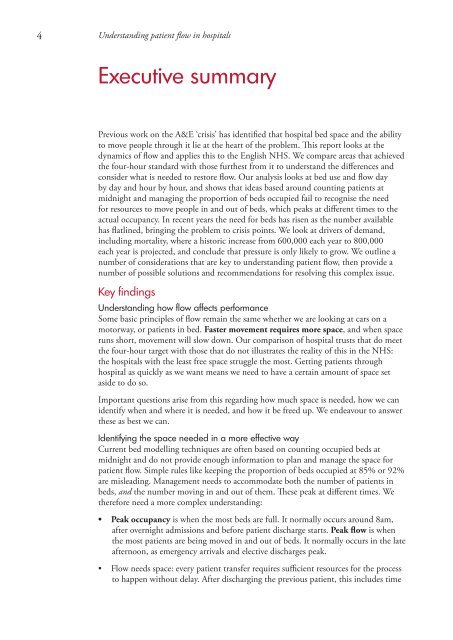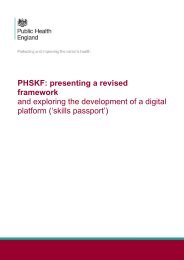Understanding patient flow in hospitals
understanding_patient_flow_in_hospitals_web_0
understanding_patient_flow_in_hospitals_web_0
You also want an ePaper? Increase the reach of your titles
YUMPU automatically turns print PDFs into web optimized ePapers that Google loves.
4 <strong>Understand<strong>in</strong>g</strong> <strong>patient</strong> <strong>flow</strong> <strong>in</strong> <strong>hospitals</strong><br />
Executive summary<br />
Previous work on the A&E ‘crisis’ has identified that hospital bed space and the ability<br />
to move people through it lie at the heart of the problem. This report looks at the<br />
dynamics of <strong>flow</strong> and applies this to the English NHS. We compare areas that achieved<br />
the four-hour standard with those furthest from it to understand the differences and<br />
consider what is needed to restore <strong>flow</strong>. Our analysis looks at bed use and <strong>flow</strong> day<br />
by day and hour by hour, and shows that ideas based around count<strong>in</strong>g <strong>patient</strong>s at<br />
midnight and manag<strong>in</strong>g the proportion of beds occupied fail to recognise the need<br />
for resources to move people <strong>in</strong> and out of beds, which peaks at different times to the<br />
actual occupancy. In recent years the need for beds has risen as the number available<br />
has flatl<strong>in</strong>ed, br<strong>in</strong>g<strong>in</strong>g the problem to crisis po<strong>in</strong>ts. We look at drivers of demand,<br />
<strong>in</strong>clud<strong>in</strong>g mortality, where a historic <strong>in</strong>crease from 600,000 each year to 800,000<br />
each year is projected, and conclude that pressure is only likely to grow. We outl<strong>in</strong>e a<br />
number of considerations that are key to understand<strong>in</strong>g <strong>patient</strong> <strong>flow</strong>, then provide a<br />
number of possible solutions and recommendations for resolv<strong>in</strong>g this complex issue.<br />
Key f<strong>in</strong>d<strong>in</strong>gs<br />
<strong>Understand<strong>in</strong>g</strong> how <strong>flow</strong> affects performance<br />
Some basic pr<strong>in</strong>ciples of <strong>flow</strong> rema<strong>in</strong> the same whether we are look<strong>in</strong>g at cars on a<br />
motorway, or <strong>patient</strong>s <strong>in</strong> bed. Faster movement requires more space, and when space<br />
runs short, movement will slow down. Our comparison of hospital trusts that do meet<br />
the four-hour target with those that do not illustrates the reality of this <strong>in</strong> the NHS:<br />
the <strong>hospitals</strong> with the least free space struggle the most. Gett<strong>in</strong>g <strong>patient</strong>s through<br />
hospital as quickly as we want means we need to have a certa<strong>in</strong> amount of space set<br />
aside to do so.<br />
Important questions arise from this regard<strong>in</strong>g how much space is needed, how we can<br />
identify when and where it is needed, and how it be freed up. We endeavour to answer<br />
these as best we can.<br />
Identify<strong>in</strong>g the space needed <strong>in</strong> a more effective way<br />
Current bed modell<strong>in</strong>g techniques are often based on count<strong>in</strong>g occupied beds at<br />
midnight and do not provide enough <strong>in</strong>formation to plan and manage the space for<br />
<strong>patient</strong> <strong>flow</strong>. Simple rules like keep<strong>in</strong>g the proportion of beds occupied at 85% or 92%<br />
are mislead<strong>in</strong>g. Management needs to accommodate both the number of <strong>patient</strong>s <strong>in</strong><br />
beds, and the number mov<strong>in</strong>g <strong>in</strong> and out of them. These peak at different times. We<br />
therefore need a more complex understand<strong>in</strong>g:<br />
• Peak occupancy is when the most beds are full. It normally occurs around 8am,<br />
after overnight admissions and before <strong>patient</strong> discharge starts. Peak <strong>flow</strong> is when<br />
the most <strong>patient</strong>s are be<strong>in</strong>g moved <strong>in</strong> and out of beds. It normally occurs <strong>in</strong> the late<br />
afternoon, as emergency arrivals and elective discharges peak.<br />
• Flow needs space: every <strong>patient</strong> transfer requires sufficient resources for the process<br />
to happen without delay. After discharg<strong>in</strong>g the previous <strong>patient</strong>, this <strong>in</strong>cludes time



